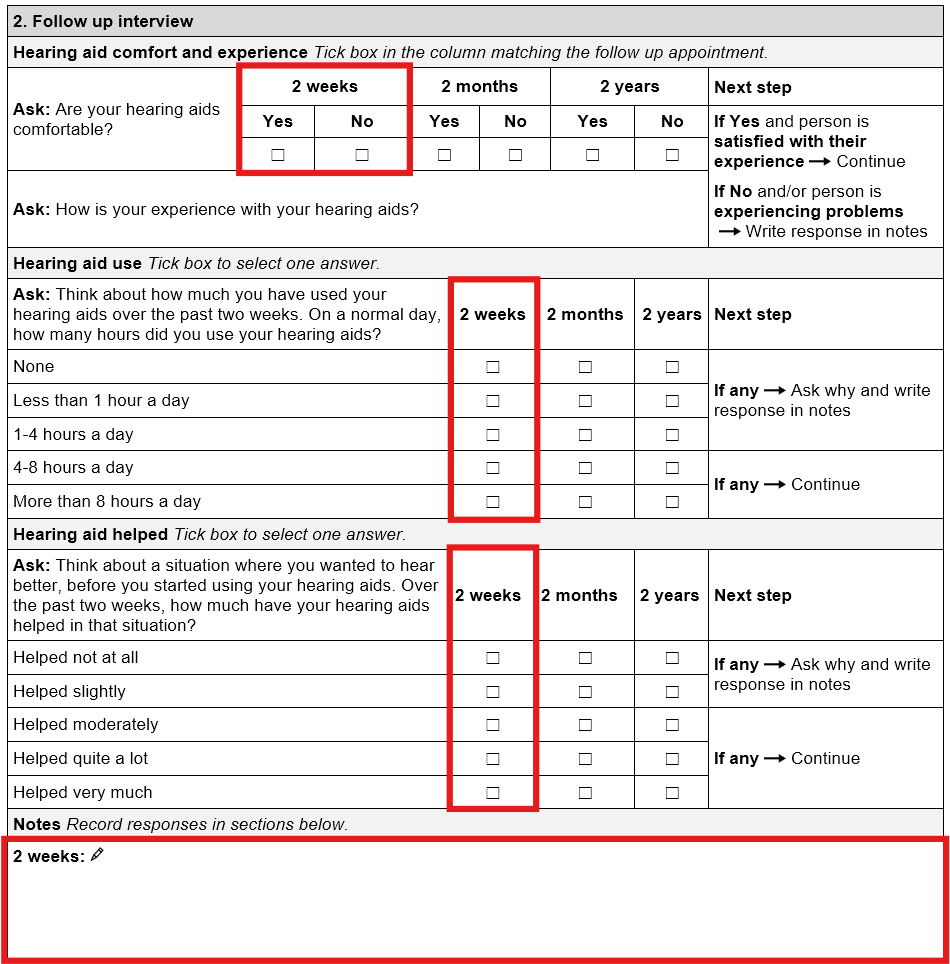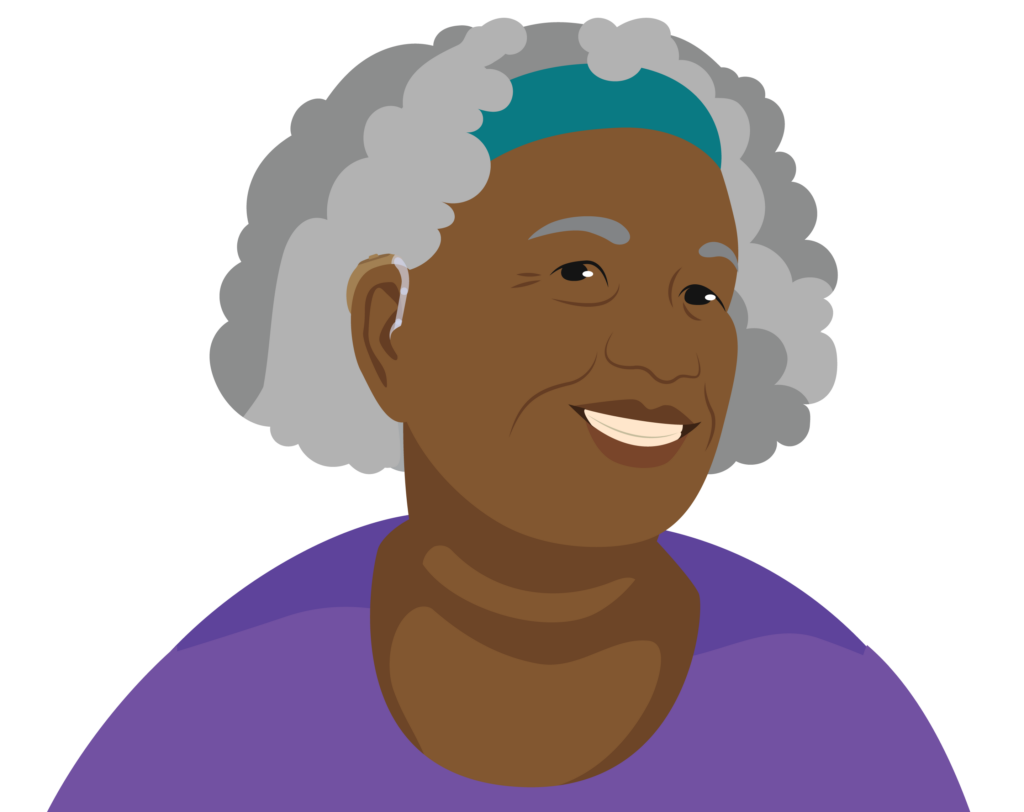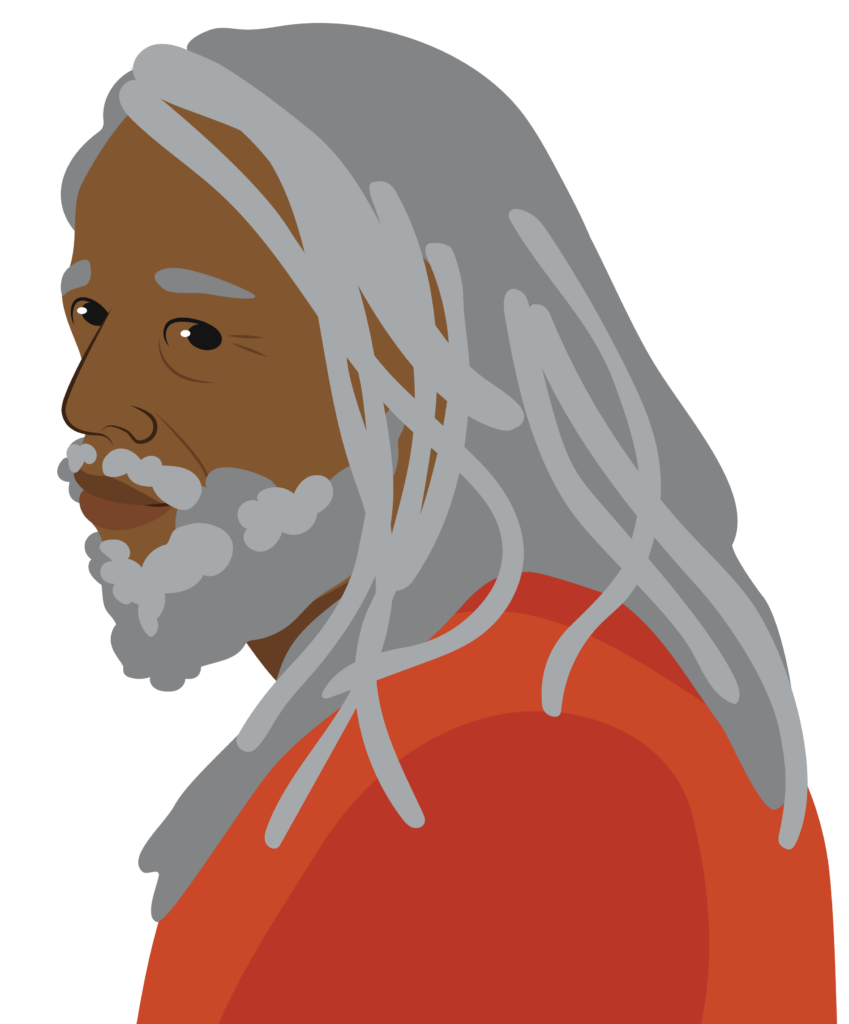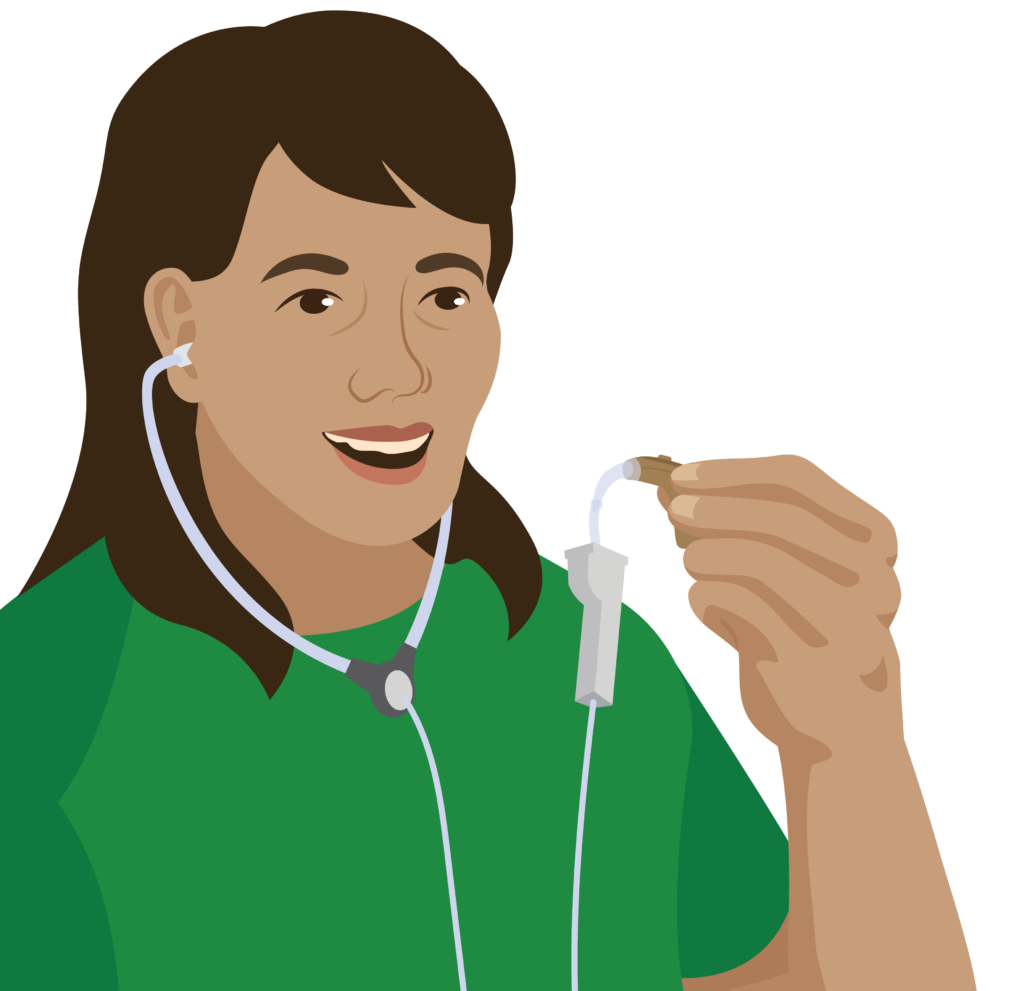Dans cette rubrique, vous apprendrez comment assurer le suivi d'un adulte auquel vous avez fourni une aide auditive.
Instruction
Si ce n'est pas encore fait, téléchargez le formulaire TAP de suivi des adultes utilisant une aide auditive préprogrammée et imprimez-en une copie.
Renseignements sur la personne
La première partie du suivi TAP d'un adulte équipé d'une aide auditive consiste à recueillir les coordonnées de la personne, notamment son nom, son genre, son âge, son numéro de téléphone et son adresse.
Instruction
Commencez par recueillir des informations générales sur la personne.
Entretien de suivi

Le même formulaire de suivi est utilisé pour les rendez-vous à :
- Deux semaines
- Deux mois
- Deux ans
Instruction
Cochez la case dans la colonne correspondant au rendez-vous de suivi.
Confort de l'aide auditive et satisfaction de l'utilisateur
Sondez la personne pour savoir si elle est satisfaite du confort et de l'utilisation de son aide auditive.
Instruction
Posez les questions suivantes :
- Votre aide auditive est-elle agréable à porter ?
- Êtes-vous satisfait de son utilisation ?
- Si la personne confirme que son aide auditive est confortable et qu'elle en est satisfaite, continuez.
- Si la personne répond par la négative ou si son aide auditive lui pose problème, ajoutez la réponse dans la section Notes.
Vous souvenez-vous de Malicka ?

Malicka est une grand-mère de 70 ans. L'agente de santé la convoque pour un rendez-vous de suivi à deux semaines. Elle lui demande si l'aide auditive préprogrammée lui rend service.
Malicka dit à l'agente de santé que son aide auditive ne la gêne pas. Par contre, le niveau sonore n'est pas confortable. Il est trop fort. L'agente de santé le consigne dans ses notes et la rassure. Elle va solutionner le problème et s'assurer que Malicka entend toujours clairement les conversations.
Utilisation de l'aide auditive
Instruction
Demandez : Comment avez-vous utilisé votre aide auditive ces deux dernières semaines. Au cours d'une journée normale, combien d'heures l'avez-vous portée ?
- Si la personne utilise habituellement son aide auditive moins de quatre heures par jour, elle n'en tire pas tout le bénéfice. Demandez-lui pourquoi et ajoutez sa réponse dans vos notes.
- Si la personne utilise habituellement son aide auditive quatre heures ou plus qutodiennement, continuez.
Conseil
Il peut être utile de tenir un journal de l'utilisation de l'aide auditive pendant les deux premières semaines, afin de consigner :
- combien de temps par jour la personne utilise son aide auditive
- dans quelles situations l'aide auditive l'a aidée ou ne l'a pas aidée
- les éventuels problèmes liés à l'utilisation de l'aide auditive
L'aide auditive a aidé
Instruction
Demandez : Pensez à une situation où vous auriez aimé entendre mieux, quand vous n'aviez pas encore d'aide auditive. Au cours des deux dernières semaines, dans quelle mesure votre aide auditive vous a-elle aidée dans une situation similaire ?
- Si la personne indique que son aide auditive ne l'a pas aidée du tout ou qu'elle l'a aidée légèrement seulement, demandez-lui pourquoi et ajoutez sa réponse dans vos notes.
- Si la personne en tire un bénéfice modéré ou plus important, continuez.
Vous souvenez-vous de Malicka ?

Malicka souhaitait mieux entendre sa famille quand tout le monde parlait ensemble à table.
L'agente de santé lui demande d'indiquer dans quelle mesure son aide auditive l'a aidée dans cette situation.
- Pas du tout
- Légèrement
- Modérément
- Beaucoup
- Énormément
Malicka indique que son aide auditive l'aide modérément dans cette situation.
L'agente de santé lui fournit des conseils pour améliorer son audition dans les environnements bruyants et pose un rendez-vous de suivi téléphonique dans deux mois pour faire le point.
Plan de suivi
Utilisez cette partie du formulaire pour définir les prochaines étapes, en concertation avec la personne.
Utilisez les réponses de l'entretien pour élaborer le plan de suivi.
Encouragez toujours la personne à revenir vous voir à tout moment si son audition ou son aide auditive lui pose problème.
Suivi à deux semaines et à deux mois
Une personne tire pleinement parti de son aide auditive si :
- elle est satisfaite du confort et de l'utilisation de son aide auditive
- elle utilise son aide auditive plus de quatre heures par jour
- son aide auditive lui est utile modérément ou plus
Instruction
- Si la personne répond oui à toutes les questions, elle tire pleinement parti de son aide auditive. Programmez le prochain rendez-vous de suivi.
- Si elle répond non à l'une des questions, elle ne tire pas pleinement parti de son aide auditive. Vérifiez les notes et essayez une solution. Si cela ne suffit pas, procédez à un suivi en personne pour vérifier l'état de ses oreilles et du produit.
- Si vous ne trouvez pas de solution, parlez-en à votre mentor et, au besoin, orientez la personne vers un spécialiste de l'oreille et de l'audition.
Question

Vous souvenez-vous de John ?
John est retraité et vit avec son épouse Mary.
L'agente de santé demande à John : « Que pensez-vous de votre aide auditive ? »
John répond qu'il est satisfait. Son aide auditive ne lui a posé aucun problème d'utilisation. Il l'utilise trois heures par jour pour regarder la télévision le soir. Ça l'aide beaucoup.
Regardez l'entretien de suivi de John :

1. John est-il satisfait du confort et de l'utilisation de son aide auditive ?
Sélectionnez une réponse.
Oui, c'est exact.
John a répondu par l'affirmative à la question sur le confort de l'aide auditive, dont l'utilisation ne lui pose aucun problème.
2. John utilise-t-il son aide auditive plus de quatre heures par jour ?
Sélectionnez une réponse.
La bonne réponse est Non.
John utilise son aide auditive trois heures par jour pour regarder la télévision. Encouragez-le à l'utiliser à d'autres moments de la journée afin qu'il puisse en tirer pleinement parti.
3. Dans quelle mesure l'aide auditive a-elle aidé John quand il regarde la télévision ?
Sélectionnez une réponse.
La bonne réponse est Énormément.
L'aide auditive aide énormément John quand il regarde la télévision.
4. Reportez-vous à la section du formulaire de suivi relative au suivi à deux semaines. John tire-t-il pleinement parti de son aide auditive ?

Sélectionnez une réponse.
La bonne réponse est Non.
Même si John est satisfait de son aide auditive et qu'il en tire un bénéfice modéré ou plus, il la porte moins de quatre heures par jour. Cela signifie qu'il n'en tire pas tout le parti possible. Il faut lui poser d'autres questions pour comprendre pourquoi.
Encouragez John à utiliser davantage son aide auditive et à accroître le nombre d'heures pendant lesquelles il l'utilise. Cela l'aidera à mieux entendre et à participer davantage.
Suivi à deux ans
Ce rendez-vous est une réévaluation. Il doit avoir lieu en personne.
Vous aurez besoin d'un formulaire de dépistage, du formulaire d'évaluation initiale de la personne et du formulaire de suivi.
Il est également important de vérifier la propreté et le fonctionnement de l'aide auditive.
Instruction
Refaites les deux examens suivants :
- Examen des oreilles
- Test de l'audition
Ajustez le programme de l'aide auditive si les résultats du test de l'audition ont changé.
Instruction
Pour tout supplément d'information sur l'examen des oreilles, reportez-vous au module TAP sur les produits d'assistance auditive.
Plan de suivi à deux ans
Continuez de poser des questions pour déterminer dans quelle mesure l'aide auditive est utile à la personne :
- Confort de l'aide auditive et satisfaction de l'utilisateur
- Utilisation de l'aide auditive
- Utilité de l'aide auditive
Instruction
- Si la réponse est Oui à toutes les questions , la personne en tire pleinement parti. Programmez un suivi dans deux ans pour refaire un examen des oreilles et un test de l'audition.
- Si la personne a répondu non à l'une des questions, elle n'en bénéficie pas pleinement. Consultez les notes et le tableau de résolution des problèmes.
- Si aucune solution n'est trouvée, parlez-en avec votre mentor et, au besoin, orientez la personne vers un spécialiste de l'oreille et de l'audition.
Question

Vous souvenez-vous de Delroy ?
Delroy a 79 ans. On lui a fourni une aide auditive à l'issue d'un test de l'audition.
Delroy revient à un rendez-vous de suivi deux ans plus tard. Vous examinez ses oreilles. Tout est normal. Vous refaites son test de l'audition et ses oreilles droite et gauche ont le même degré de perte d'audition qu'il y a deux ans.
Delroy indique qu'il utilise son aide auditive huit heures par jour et qu'il en est globalement satisfait.
Que faites-vous ?
Sélectionnez une réponse.
Si vous avez choisi la réponse d, vous avez raison.
Delroy est un adulte. Il doit revenir pour un suivi en personne dans deux ans. Demandez-lui de contacter le service avant cela si son aide auditive lui pose problème.
Avertissement
Parlez-en avec votre mentor si les résultats du test de l'audition de la personne ont sensiblement changé, par exemple si vous constatez plus d'un degré de perte d'audition depuis le dernier rendez-vous.
Vérification du produit
Vérifiez le produit au rendez-vous de suivi à deux ans.
Utilisez un tube d'écoute et les six sons de Ling pour vérifier le fonctionnement de chaque aide auditive :
- Si les deux aides auditives sont propres et fonctionnent normalement, aucune action n'est requise.
- Si l'une des aides auditives ou les deux ne fonctionnent pas, nettoyez-les et remplacez les pièces usagées ou endommagées. Si cela ne suffit pas, parlez-en avec votre mentor et, le cas échéant, envoyez les prothèses au fabricant.
Consultez le tableau de résolution des problèmes si la personne décrit des problèmes liés au fonctionnement de son aide auditive.

Instruction
Cochez la case indiquant que l'aide auditive est propre et fonctionne normalement, si c'est le cas.